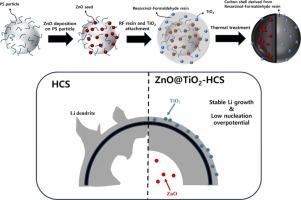二次电池中锂金属阳极的亲锂氧化锌和疏锂tio2工程控制空心碳纳米球的锂沉积
IF 6.3
2区 材料科学
Q2 CHEMISTRY, PHYSICAL
引用次数: 0
摘要
金属锂由于其特殊的能量密度而被认为是一种极具潜力的负极材料。然而,它面临着一些挑战,包括不规则的锂枝晶生长,循环过程中的体积变化,以及低库仑效率。在各种解决方案中,空心碳球(hcs)因其为锂沉积提供稳定空间和适应体积变化的能力而备受关注。然而,hcs内部和外部碳衬里的相同性质以及锂离子沿着亲锂碳壳的迁移带来了一些挑战,因为树突可以在碳壳外形成,从而降低电池性能。为了克服这些挑战,本研究提出了一种新的HCS结构,将ZnO种子引入HCS的空白空间,并将碳壳与TiO2复合。ZnO具有比碳更高的亲锂性,有利于在碳壳内部空间内均匀沉积锂。同时,碳壳与憎石TiO2结合降低了壳的亲石性,成功抑制了锂离子沿外层碳壳移动而形成的锂枝晶。这种双功能设计抑制了锂枝晶,显著提高了电化学和循环性能。采用SEM、TEM和TEM- eds对HCS结构的形貌和元素分散进行了表征。电化学分析表明,该材料具有较低的成核过电位,即使在500次循环后仍保持约100%的库仑效率,表现出优异的循环性能。本文章由计算机程序翻译,如有差异,请以英文原文为准。

Controlling Lithium Deposition of Hollow Carbon Nanospheres via Lithiophilic-ZnO and Lithiophobic-TiO₂ Engineering for Lithium Metal Anodes in Secondary Batteries
Lithium metal is regarded as a highly potential anode material owing to its exceptional energy density. However, it faces several challenges, including irregular lithium dendrite growth, volume changes during cycling, and low Coulombic efficiency. Among various solutions, hollow carbon spheres (HCSs) have been highlighted for their ability to provide a stable space for lithium deposition and to accommodate volume changes. However, the identical nature of the inner and outer carbon linings in HCSs and the migration of Li ions along the lithiophilic carbon shell pose some challenges, because dendrites can form outside the carbon shell, thereby degrading battery performance. To overcome these challenges, this study proposes a novel HCS structure in which ZnO seeds are introduced into the empty space of the HCS and the carbon shell is composited with TiO2. ZnO, with higher lithiophilicity than carbon, preferentially facilitates uniform lithium deposition within the inner space of the carbon shell. Simultaneously, the carbon shell combined with lithiophobic TiO2 reduces the lithiophilicity of the shell, successfully suppressing Li dendrite formation caused by the movement of Li ions along the outer carbon shell. This dual-functional design suppresses Li dendrites, significantly enhancing electrochemical and cycle performance. The morphology and elemental dispersion of the proposed HCS structure were confirmed using SEM, TEM, and TEM-EDS. Electrochemical analysis revealed that the proposed material exhibited a low nucleation overpotential and maintained approximately 100% Coulombic efficiency even after 500 cycles, demonstrating excellent cycling performance.
求助全文
通过发布文献求助,成功后即可免费获取论文全文。
去求助
来源期刊

Journal of Alloys and Compounds
工程技术-材料科学:综合
CiteScore
11.10
自引率
14.50%
发文量
5146
审稿时长
67 days
期刊介绍:
The Journal of Alloys and Compounds is intended to serve as an international medium for the publication of work on solid materials comprising compounds as well as alloys. Its great strength lies in the diversity of discipline which it encompasses, drawing together results from materials science, solid-state chemistry and physics.
 求助内容:
求助内容: 应助结果提醒方式:
应助结果提醒方式:


